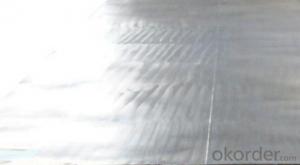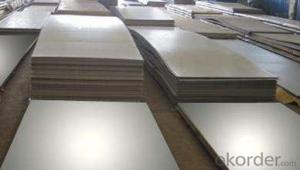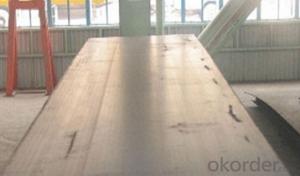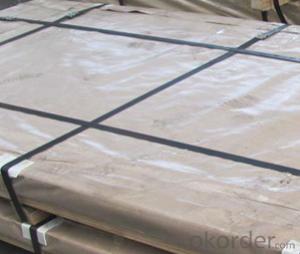Hot Rolled Carbon Steel Sheet Plate, ASTM A36 CNBM
- Loading Port:
- Qingdao
- Payment Terms:
- TT OR LC
- Min Order Qty:
- 10 pc
- Supply Capability:
- 30 pc/month
OKorder Service Pledge
Quality Product, Order Online Tracking, Timely Delivery
OKorder Financial Service
Credit Rating, Credit Services, Credit Purchasing
You Might Also Like
Quick Details
| Standard: | AISI, ASTM, DIN, GB, JIS | Grade: | A572,A573,A633,A678,A709,A710,G3101,G3136,etc | Thickness: | 1mm-200mm |
| Brand Name: | SHOU GANG GROUP, AN STEEL | Model Number: | Q235 | ||
| Type: | Steel Plate | Technique: | Hot Rolled | Surface Treatment: | Coated |
| Application: | widely | Special Use: | High-strength Steel Plate | Width: | 1000mm-3000mm |
| Length: | 1000mm-12000mm | Price Term: | FOB CIF CFR |
Packaging & Delivery
| Packaging Details: | standard seaworthy export packing or as the request of customers |
| Delivery Detail: | 10 days after deposit or according to customers' quantity |
Specifications
hot rolled carbon steel sheet
1.Thickness:1mm-200mm
2.Length:1000mm-12000mm
3.Width:1000mm-2000mm
hot rolled carbon steel sheet
| Product | HR steel plate prices carbon steel plate prices per kg |
| MOQ | 25 ton |
| Thickness | 1mm-200mm |
| Width | 1000mm-3000mm |
| Length | 1000mm-12000mm |
| Application | widely |
| Standard | AISI,ASTM,BS,DIN,JIS,GB,etc |
| Grade | A572,A573,A633,A678,A709,A710,G3101,G3136,etc |
| Tpye | Steel plate |
| Surfacing | Coated |
| Productive Technology | Hot Rolled & Cold Rolled |
| Port | |
| Payment Terms | L/C,T/T,Western Union,MoneyGram |
| Product Ability | 5000 tons per month |
| Delivery | 10 days after deposit or according to customers' quantity |
| Packing | standard seaworthy export packing or as the request of customers |
- Q:How do steel sheets compare to other materials like aluminum or plastic?
- Steel sheets have several advantages over other materials like aluminum or plastic. Firstly, steel is much stronger and more durable than both aluminum and plastic. It has a higher tensile strength and can withstand much greater loads and impacts. This makes steel sheets more suitable for applications that require high strength and structural integrity, such as construction, automotive, and aerospace industries. Secondly, steel is more resistant to extreme temperatures and fire compared to aluminum or plastic. Steel sheets have a higher melting point, making them less likely to deform or lose their structural integrity under high temperatures. This makes steel sheets ideal for applications that involve exposure to heat or fire, such as industrial furnaces or fire-resistant structures. Furthermore, steel sheets offer better corrosion resistance than aluminum or plastic. Steel can be coated with various protective layers like zinc or paint to prevent rusting and corrosion. Aluminum, on the other hand, is prone to corrosion in certain environments. Plastic, although generally resistant to corrosion, may degrade and become brittle over time. Therefore, steel sheets are a more reliable choice in applications where exposure to moisture or corrosive substances is a concern, such as marine environments or chemical processing plants. Lastly, steel sheets are more environmentally friendly than both aluminum and plastic. Steel is a recyclable material and can be reused indefinitely without losing its properties. Aluminum recycling requires significantly more energy, and plastic is known to have a detrimental impact on the environment due to its slow decomposition. Steel sheets, being recyclable and sustainable, are a preferred choice for those seeking environmentally friendly options. In conclusion, steel sheets outperform materials like aluminum or plastic in terms of strength, durability, resistance to extreme temperatures and corrosion, as well as being more environmentally friendly. However, the specific choice of material ultimately depends on the application requirements, cost considerations, and other factors.
- Q:What are the different sheet metal stamping techniques for steel sheets?
- There are several sheet metal stamping techniques for steel sheets, including blanking, piercing, bending, deep drawing, and embossing.
- Q:Can steel sheets be used for manufacturing architectural elements?
- Yes, steel sheets can be used for manufacturing architectural elements. Steel is a versatile material that offers strength, durability, and design flexibility, making it suitable for various architectural applications such as roofing, cladding, façades, and structural components. Steel sheets can be easily shaped, cut, and welded to create customized architectural elements that meet specific functional and aesthetic requirements. Additionally, steel's corrosion resistance properties make it a suitable choice for both interior and exterior architectural applications, ensuring longevity and low maintenance.
- Q:How are steel sheets cleaned and maintained?
- Steel sheets are typically cleaned and maintained by removing any dirt or grime using a mild detergent or degreaser, followed by rinsing with clean water. To prevent corrosion, a protective coating such as paint or galvanizing is often applied. Regular inspections and prompt repairs of any damages are also essential for proper maintenance of steel sheets.
- Q:What are the different types of finishes available for steel sheets?
- There are several types of finishes available for steel sheets, including mill finish, brushed finish, mirror finish, galvanized finish, and painted finish.
- Q:How do steel sheets handle static electricity?
- Steel sheets are generally good conductors of electricity, including static electricity. This means that when static electricity is present, it will easily flow through the steel sheet and dissipate, reducing the likelihood of any buildup or discharge of static electricity.
- Q:Can steel sheets be used in high-temperature applications?
- Yes, steel sheets can be used in high-temperature applications due to their excellent heat resistance properties. Steel sheets are commonly used in industries such as automotive, aerospace, and manufacturing where high temperatures are encountered.
- Q:What are the different surface protection methods for steel sheets?
- There are several different surface protection methods for steel sheets, including painting, galvanizing, powder coating, and applying protective films.
- Q:Are the steel sheets suitable for structural applications?
- Yes, steel sheets are suitable for structural applications due to their strength, durability, and versatility. They can be used in various construction projects to provide structural support and stability.
- Q:What are the standard sizes for steel sheets?
- The standard sizes for steel sheets vary, but commonly they are available in 4 feet by 8 feet, 4 feet by 10 feet, and 5 feet by 10 feet dimensions.
1. Manufacturer Overview |
|
|---|---|
| Location | |
| Year Established | |
| Annual Output Value | |
| Main Markets | |
| Company Certifications | |
2. Manufacturer Certificates |
|
|---|---|
| a) Certification Name | |
| Range | |
| Reference | |
| Validity Period | |
3. Manufacturer Capability |
|
|---|---|
| a)Trade Capacity | |
| Nearest Port | |
| Export Percentage | |
| No.of Employees in Trade Department | |
| Language Spoken: | |
| b)Factory Information | |
| Factory Size: | |
| No. of Production Lines | |
| Contract Manufacturing | |
| Product Price Range | |
Send your message to us
Hot Rolled Carbon Steel Sheet Plate, ASTM A36 CNBM
- Loading Port:
- Qingdao
- Payment Terms:
- TT OR LC
- Min Order Qty:
- 10 pc
- Supply Capability:
- 30 pc/month
OKorder Service Pledge
Quality Product, Order Online Tracking, Timely Delivery
OKorder Financial Service
Credit Rating, Credit Services, Credit Purchasing
Similar products
New products
Hot products
Related keywords































